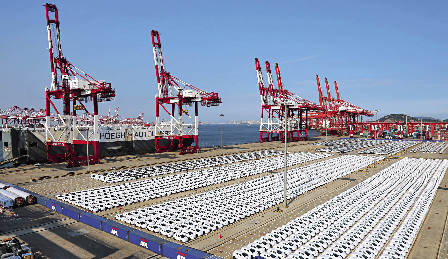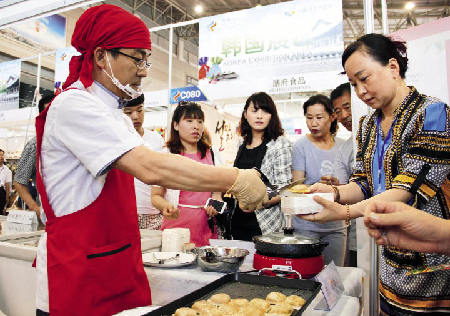China-South Korea FTA Revs up Shandong’s Foreign Trade
By WANG ZHE
RECENT years have witnessed an ever-closer trade relationship between China and South Korea. “Every Korean uses Chinese products in daily life, and vice versa,” Chinese Commerce Minister Gao Hucheng said in an article published in People’s Daily last June. “The bilateral trade accounts for more than a fifth of Korea’s total foreign trade, exceeding the total of its trade with the U.S. and the EU.”
On June 1, 2015 the Chinese and South Korean governments officially signed a free trade agreement (FTA) in Seoul. Chinese provinces then engaged in a new round of competition for a market share. Shandong, that closest to South Korea, grasped the initiative by virtue of this geographical advantage and its history of cooperation with the ROK.
 |
| The first roro ship importing 1650 Renault cars to China arrives at Qingdao Harbor. |
Jinan: Emerging Regional Logistic Center
The multitudes of Chinese youth that buy clothes online are familiar with Hstyle, the Internet fast fashion brand and agent for Korean clothing. Based in Jinan, capital of Shandong, the company plans to work with more Korean fashion brands and introduce them to the Chinese market while at the same time advancing towards the Korean market. As more Korean companies set up offices in Shandong, the province is rapidly becoming a center of gravity and distribution center for Korean products.
Founder of the Handu Group Zhao Yingguang established Hstyle in 2006. His main aim to rapidly establish an on-line clothing brand, Zhao decided to start out as a purchasing agent for Korean garments. It was not long before Hstyle workers figured out the design elements and characteristics of Korean fashion, and began to try their own hand at original designs. By 2008, the company had transformed itself into a registered Internet-based Korean-fashion brand with three Korean media celebrities: actress Jun Ji-hyun, male model Ahn Jae-hyun, and actress, singer and dancer Park Shin-hye as its brand repesentatives.
On June 26, 2015, the Handu Group signed a strategic cooperation agreement with PROSPECS – so-called “Nike of Korea” – whereby Hstyle acts as this top Korean sports brand’s agent in China. This is just one of Hstyle’s main directions, its ambition being to establish close relationships with more Korean clothing, shoe, hat, and cosmetic brands and bring them to China through e-commerce.
In view of the rapid advancement of the FTA, Hstyle is also contemplating entering the Korean market. “The China-Korea FTA provides a channel for Chinese commodities to enter the Korean market,” said Hu Jindong, vice general manager of Handu. “We have occupied a favorable position in the cut-throat Chinese market, and as we are familiar with the Korean market, are well able to stand our ground there.”
Jinan is exploiting its advantage as sole national comprehensive bonded central and west Shandong Province by constructing an exhibition and trading center for Chinese, Japanese, and Korean bulk commodities. The center will also act as an e-business platform for the three countries’ products, making the city a pioneer and model of cross-border trade. Preferential tax and logistics policies and its position as regional transportation hub have empowered Jinan to improve the functions and operations of the cross-border e-business platform to act also as a distribution center for Korean commodities.
Qingdao: Facilitate Cross-border Cooperation
On the day of the FTA’s signing, the Qingdao municipal government issued an action plan to further promote opening-up and cooperation with South Korea from 2015 to 2016. By the year 2020, Qingdao aims to achieve US $20 billion in foreign trade – double the 2015 level – and to attract US $20 billion in investment from Korea. The port city also plans to double its current level of investment in Korea to US $500 million by 2020.
Thanks to its close geographical and cultural proximity, Qingdao has remained the city in Shandong Province that leads economic and trade cooperation with South Korea. It is also one of the major sites of Korea-invested corporations. Qingdao enjoys unique advantages in its trade cooperation with South Korea.
There are 182 weekly flights and around 20 shipping routes between Qingdao and Korean cities. About 100,000 Koreans live in Qingdao, evident in such institutions as the Korean Consulate-general, Korea Trade-investment Promotion Agency, and Korea Business Development Centers. South Korea is also Qingdao’s biggest source of tourism, having welcomed more than a million Korean visitors over the last three years.
The city is planning to construct on its west coast the China-South Korean Innovation Industry Park. It will encompass a slew of major projects such as the China-South Korea composite new city, and Yonsei University dental hospital. Qingdao is also applying to make the park a national key project, so utilizing national resources to promote cooperation between Qingdao and South Korea.
Last July, China’s central bank approved Qingdao as a pilot zone wherein Chinese companies can take out RMB loans from South Korean banks. Qingdao thus became the only pilot city of this kind. Within a month, companies in Qingdao had taken out loans totaling RMB 3 billion from South Korean banks, at ever lower rates of interest.
On August 27, a Qingdao municipal delegation arrived in the harbor city of Busan in Southeast Korea. There it held the signing and launching ceremony of the Qingdao Industrial and Commercial Center in Korea, which is expected to promote all-round economic cooperation at the local level.
 |
| The Sixth Weihai International Food Expo last June wooed many locals. |
Weihai: An FTA Experiment
“A rooster crowing in Weihai wakes people up in Incheon.” As this Korean saying implies, Weihai, on the east tip of the Shandong Peninsula, is within sight of South Korea across the ocean. The China-South Korea FTA innovatively introduced items pertaining to local economic cooperation, and so listed Weihai and Incheon as model regions in this regard. Such innovation made bilateral cooperation more practical and workable. Weihai acts as an experimental field in which to explore the possibility of and promote cooperation experience.
It is now possible to fly from Weihai to Incheon in 50 minutes. Every week, 28 flights and 30 liner ships ply the two cities, transporting more than a million passengers to South Korea every year. On July 22, 2015, a liner carrying garments and cosmetics sailed from Incheon to Weihai, resuming a regular route that ceased operating seven years ago. The first maritime postal route between the two neighboring countries, it takes about the same time as air transportation, but at a cost 70 percent lower.
A Korean-style gate bearing inscriptions by Yeosu Mayor Kim Chung-seog is the entrance to the Korean Commodity Trade Center of Weihai. There can be found Korean foods, cosmetics, daily goods, bedding articles, stationery, and household electrical appliances. Next door to the center is Hanyuefang, the first South Korean cultural theme park in China that includes a pedestrian street, a cultural and art gallery, a performance center, the Lotte Cultural Square, a Korean night market, and a Korean folklore street.
As the first and also sole Chinese city to be included in the FTA between China and South Korea, Weihai has embarked on a primary implementation plan to accelerate local cooperation. It includes five food and daily use article commodity trading centers, three of which have opened, and one that is inviting tenants. The national logistics center for Korean commodities and tariff-free goods exhibition and trade center are currently under construction.
Yantai: Korean Enterprises Convergence
In March 2005, the wrecks of two Korean ships from about 800 years ago were dredged up during excavations in Yantai – a discovery that caused a sensation in Korean archaeological circles.
Trade and cultural exchanges between Yantai and the Korean Peninsula go back 2,600 years ago, and were fully detailed in Chinese historical records. Around 1,000 years ago, Yantai was one of China’s four main trading ports. Its prosperity is evident in many poems. One so describes it: “The rising sun shines on a thousand ship sails, and sets amid ten thousand lighted lamps.” A regular shipping route to Yantai was established in 1883, when Incheon first became a commercial port.
As it is only 237 sea miles, or 13 hours of sailing, to Pyeongtaek City, fresh farm products shipped from Yantai in the afternoon can be served on the tables of Korean families by noon the next day.
Yantai is also site of the largest number of Korean companies in China. It welcomed the first Korea-invested company in 1989, before the bilateral diplomatic relationship had been established. Thus far, 432 Korean companies have set up offices in the Yantai Development Zone, 18 of which are listed in the World Top 500, including LG, Doosan, Hyundai, and Daewoo. Korean companies brought in more than 200 projects with funding levels of US $10 million and which registered total foreign investments of more than US $4 billion. Thanks to such prestigious Korean firms, Yantai Development Zone has become China’s largest production base for excavators, smart phones, autos and auto parts, so increasing the degree of industrial relevance and complementarity with South Korea.
In light of the close geographic proximity and similar cultural backgrounds, Korean companies have rarely taken long to adapt to the new environment in Yantai. LG Display, LGEYT and two other LG subsidiaries have developed a full product chain of smart phones – from R&D to manufacture to sale. Since the third phase went into operation, the LG Display accounts for a third of the world’s screen output, making Yantai the most important screen production base. Hyundai Motors have also invested RMB 1.2 billion in constructing an R&D center for new-energy autos. Since the new office building was completed, some have begun test runs.
Hop on the FTA Fast Track
For China, the FTA with South Korea is the most comprehensive ever as regards items, and involves the largest foreign trading volume. After going into effect at the end of 2015, more than 90 percent of commodities will enjoy zero tariffs between the two countries. It is estimated that within five years bilateral trade will surpass US $400 billion, as compared to US $90 billion in 2004, when the FTA feasibility study was initiated. In 2014, the figure soared to about US $300 billion, signifying an annual growth of 22.3 percent.
In line with the rising trend in trade, South Korean companies have chosen to invest and settle in Shandong, making the province a center of gravity and distribution hub for Korean goods. According to the provincial department of commerce, South Korea accumulatively invested US $31.67 billion in Shandong, accounting for a fourth of its total investment in China. Some 5,000 South Korean companies operate in Shandong.
Zheng Guibin, director of Shandong Development and Research Center and vice director of Shandong Blue Economy Research Institute, believes that Shandong, by virtue of its geographical advantages, leads the whole country in implementing the China-South Korea FTA. A series of preferential policies, including reducing tariffs, facilitating trade and investment, and expanding room for cooperation, will energize Shandong’s economy. It will also usher in the historical opportunity to speed up the province’s industrial restructuring and upgrading and construction of an open economy.
WANG ZHE is a journalist with China Report magazine.
